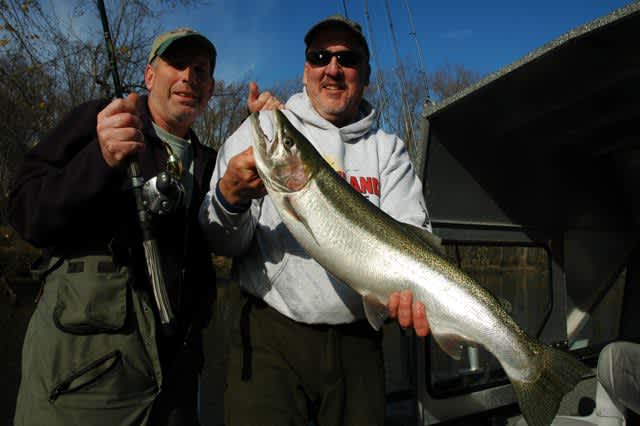Michigan Steelheading, Frostbite Style
Dave Mull 10.25.12

Tony Wolte blasted his tricked-out jet boat “Fat Sally” down the Kalamazoo River, throttled back and stopped along an obvious eddy in the medium-sized tributary of Lake Michigan. The electric winch soon had the 100-pound chain anchor on the bottom, just eight feet below us, and other than the soft sound of water rushing against the aluminum hull, the quiet of an autumn morning in western Michigan returned.
Wolte, a licensed captain who runs Frostbite Charters (616-836-8452), soon had two diving crankbaits on either side of the boat, a couple of classic Storm Wiggle Warts to port, and two Brad’s Wigglers—nearly identical to Wiggle Warts—to starboard. Gold and orange or red color patterns were the choice in this grayish day. Before long, the inside port rod bowed and a big silvery steelhead somersaulted out of the water. It was one of four we’d get to hit that day, two on crankbaits and two on spawn.
Wolte is a river rat and proud of it. Living on the banks of the Kalamazoo River near New Richmond, he has been a charter captain for six years, taking clients fishing on Lake Michigan as well as area rivers.

He spends lots of summer days trolling for offshore salmon and many a summer night anchored on the Kalamazoo waiting for big, flathead catfish to bite hooks baited with live bluegills. However, he admits his first love is chasing steelhead and the occasional brown trout in the rivers. His “home” river, the Ka’zoo, gets most of his attention, but he trailers his 20-foot, covered aluminum boat with its 175-horsepower jet outboard down to the nearby St. Joseph River upon news of good fishing in that tributary.
This day, Michigan writer Steve Griffin and John Mazurkiewicz, who lives in South Bend, Indiana and handles public relations for Shimano and some other fishing companies, were along.
Wolte usually takes a one-two punch approach to steelies on the slow-moving Kalamazoo, the first punch being crankbaits, the second punch being bait—waxworms or spawn bags—beneath a bobber. On the St. Joe, with its faster current, he leaves the float rods at home and “walks” spawn along the riverbed, bouncing a weight on the bottom.
Wolte spools his crankbait rigs with 14-pound Power Pro, terminating with three-foot leaders of 12-pound test Blood Run Fluorocarbon. Reels are Shimano Tekota 300 Line Counters, and lures go back 40 feet back on side rods and 50 feet on corner rods. By lifting his chain anchor and maneuvering with a bow-mount MinnKota trolling motor, Wolte meticulously combs the lower water column. Corner rods are 8-foot, 6-inch medium-power, fast-action St. Croix spinning rods; side rods are nine-footers, custom tied on Cedar brand, nine-weight fly-rod blanks.
To cover more width in the river, Wolte sometimes employs Hot Shot side planers, which are small, plastic gizmos that clip to your fishing line and “plane” it out to the side. These are a match made in heaven for crankbaits and the river. They allow an angler to ease a crankbait right alongside of shoreline logs, rocks and other structure that steelhead use to get out of the current.

With the crankbait rods set, Wolte hands his guests 12-foot, 6-inch float rods baited up with waxworms or spawn bags. In place of the popular center-pin reels, Wolte clamps on Abu Garcia 5500 baitcast reels with 12-pound test P-Line copolymer line.
“I like using bigger floats, too,” Wolte says. “Just so people can see them. When you’re letting a bobber go behind the boat, you can let it go a long way–100 yards and more sometimes. Little bobbers are hard to see.”
Baitcasters work great for letting line go out to match the current, and offer some advantages over center-pins, Wolte says. For one, they’re much quicker when it comes to reeling in your float and bait for another drift, since center-pins come in at a 1:1 ratio. And, since most center-pins don’t have a drag, fighting fish takes some practice–you basically let the reel spool spin backwards. The knobs on the reel are prone to hitting your hand, and center-pin reels have earned the nickname “knucklebusters.”
“Baitcast reels are just easier for my customers to use,” says Wolte.
He is definitely on to something. Although I started trying more than five years ago. I’m basically still inept when it comes to casting and controlling a center-pin rig. Baitcasters are much, much easier.
As of this writing with just a week left in October, steelhead were just starting to show up in Michigan tributaries. Time to use a Frostbite technique and start catching them.
For more information on Michigan fishing go to michigan.org.

